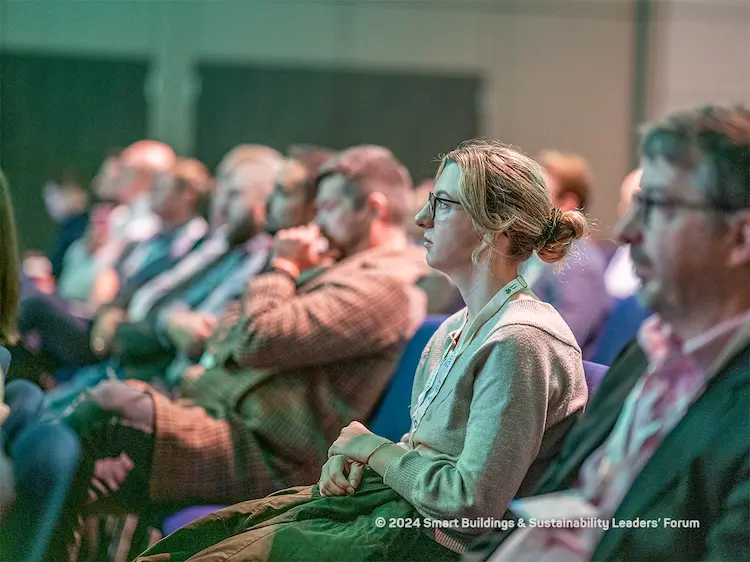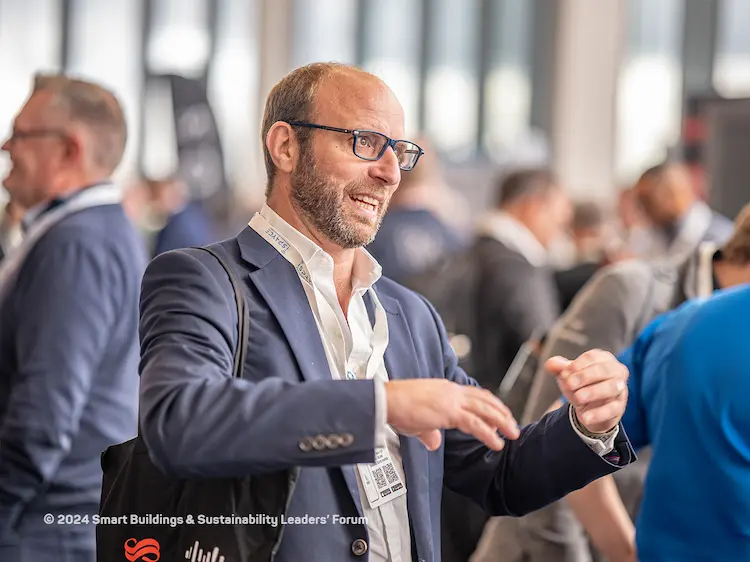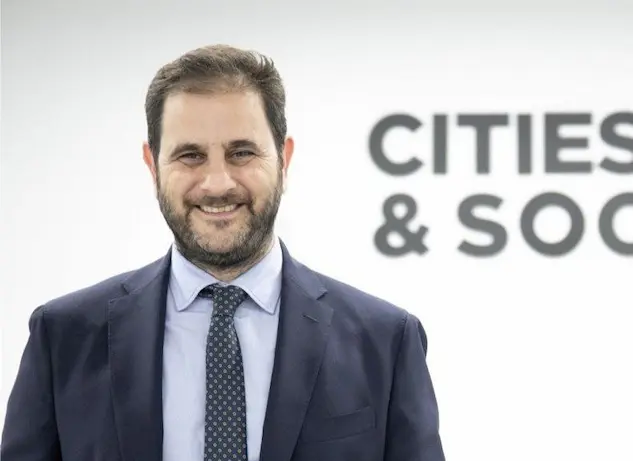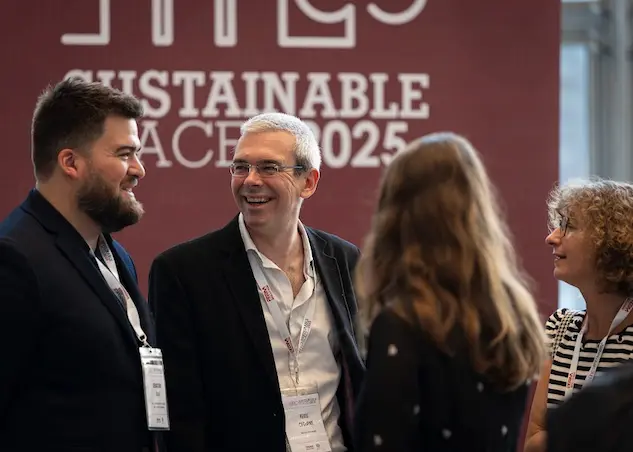As part of our partnership with the Smart Building and Sustainability Leaders Forum, we spoke with Geoff Archenhold, Chair and Co-Founder of the event, to discuss the Forum’s unique approach to driving practical change in the built environment sector. Set to take place next month, the SBS Forum has quickly gained recognition as a vital platform for cross-sector collaboration on smart and sustainable buildings. In this interview, Geoff shares the vision behind the Forum, the challenges it aims to address, and why bridging the gap between technology, policy, and real-world implementation is more urgent than ever.

Rethinking industry dialogue: why the SBS Forum matters now
The SBS Forum is redefining industry dialogue around smart and sustainable buildings. What role does it play in this shift, and why launch it now?
The forum aims to bridge the gap between knowledge, innovation and implementation. Rather than replicating passive, sales-driven conferences, it fosters active dialogue and cross-sector collaboration among technologists, end-users, sustainability experts, policymakers and property owners. This exchange often reveals how certain sectors have overcome the challenges that others are still facing, and multiple sectoral plenary themes allow these insights to be shared more broadly across industry.
The forum also seeks to create a unified vision by aligning fragmented efforts across smart building technologies, ESG goals, and net-zero strategies. By bringing together diverse voices, it helps shape a shared language and roadmap for sustainable transformation. Its focus is on accelerating real-world impact, not just exploring future possibilities.
Through pilot projects, case studies, and policy recommendations, the forum drives practical change in how buildings are designed, operated, and retrofitted. The conference content reflects the maturity of smart technologies like IoT, AI, and digital twins, which are now ready for large-scale use, along with other technologies that enhance performance, support occupant well-being, reduce emissions, and promote circular economy principles.
The SBS Leaders’ Forum emerged from the urgent need for education, dialogue and co-ordinated action to meet 2030 and 2050 net-zero targets, recognizing that the built environment contributes nearly 40% of global emissions. SBS offers an unbiased, user-focused space — a relaxed, informative networking environment where leaders can focus on real solutions that improve the operational management of estates, lower energy usage and carbon emissions, and support digital transformation.
As governments and investors ramp up support for green infrastructure, the forum helps stakeholders navigate this shift and identify new opportunities. Importantly, it acknowledges that sustainability is a leadership challenge as much as a technical one, empowering leaders to share insights and drive change.
From insight to implementation
How is the program designed to ensure participants leave with practical strategies?
The forum is intentionally curated by panels of sector experts to ensure participants leave with increased knowledge and practical strategies to move forward with increased confidence in smart building projects. Each plenary addresses a number real-world themes highlighted as pressing in certain end-user sectors, for example cybersecurity, interoperability and scalability, but perhaps most importantly, the forum openly promotes cross-disciplinary dialogue and encourages collaboration from all stakeholders, from Facilities & Sustainability Managers, IT & Data Teams, to Finance teams and end-users (staff and service users)
Speaker sessions favour an interactive format to ensure full attendee engagement, such as panel Q&A sessions, which are designed to encourage lively peer exchange. There are also interactive workshop sessions, allowing for even greater engagement in-depth learning.
Speakers are not only selected for their expertise, but also for their ability to openly share lessons learned, pitfalls to avoid, and propose frameworks for their industry colleagues to replicate. A great example of this is within the Digital Healthcare, Smart Hospitals and Virtual Wards plenary, where several of the speakers not only have a clinical background, but also have experience in implementing digital technologies. They are therefore able to share invaluable insights as to how technology can help or hinder staff and patients, and what has worked or will not work – and the reasons why. Such a line-up provides a powerful interface and invites important discussions between technology providers and end users.
Which specific gaps in industry dialogue does the forum seek to bridge?
The Smart Building and Sustainability Leaders Forum sets out to address several fragmentated areas in the built environment and bridge the following gaps:
Technology vs. Strategy: Technology providers often speak in terms of features and capabilities, while building owners and operators need to understand immediate benefits and outcome-driven solutions. The SBS forum’s role is to encourage technology companies to translate innovation/digital technologies into business value, helping stakeholders understand how smart technologies align with sustainability goals, compliance, and ROI.
Sustainability vs. Operations: Sustainability teams focus on long-term goals (e.g., achieving net-zero), while operations teams are tasked with day-to-day performance and cost control. The forum aims to foster dialogue between these groups, showing how smart building systems can serve both agendas — improving operational efficiency, whilst simultaneously reducing emissions.
Policy vs. Practice: Policymakers set ambitious targets, but practitioners often lack clarity on how to implement them within existing constraints. This is why there are very few truly net zero buildings in existence today! The forum is designed to bring together regulators, advisors, and industry leaders to demystify compliance, share best practice, and co-develop scalable pathways.
Data vs. Decision-Making: Buildings generate vast amounts of data, but many organizations struggle to turn it into actionable insights. By showcasing real-world examples of data-driven decision-making — from predictive maintenance to ESG reporting — the SBS forum promotes data literacy across all stakeholders.

Scaling decarbonization: UK innovations and investment shifts
Which innovations or trends seem most promising for scaling impact, especially in the UK?
There are several promising trends for decarbonizing the built environment in the UK, such as:
- Decentralized DC Grid Renewable Energy Systems: integration of solar, heat pumps, and storage directly into buildings, lowering dependence on the main grid and improving energy resilience.
- Retrofit at Scale: upgrading older buildings—common in the UK—with smart controls, better insulation, low-carbon heating, and DC grids. Such retrofits can cut emissions by up to 60–80%, as seen in Cardiff Metropolitan University’s major energy savings on its 1970s campus.
- Whole-Life Carbon Accounting is expanding the focus beyond operational emissions to include embodied carbon from materials, construction, and end-of-life processes. Firms like Crowe are beginning to demonstrate how carbon accounting is influencing financial planning and though its impact remains limited, it is growing.
- Smart Building Technologies like IoT, AI, and digital twins enable real-time emissions tracking, predictive maintenance, and efficient energy management using low-cost, scalable sensors and systems.
- Material Innovation & Circularity focuses on low-carbon materials, re-use strategies, and material passports, helping reduce embodied carbon and promote circular economy models.
- Digital Carbon Compliance Tools automate ESG reporting and audits, making it easier for organizations to meet UK and EU regulations while increasing transparency.
- Collaborative Ecosystems & Policy Alignment emphasize public-private partnerships and cross-sector cooperation. This is especially relevant in the UK as the government plans to leverage such models for modernizing schools and healthcare infrastructure in the coming years.
How is the UK market evolving in investment and policy to support net zero and sustainable buildings?
In terms of policy evolution, several key trends are emerging:
- Whole-Life Carbon Focus: The Environmental Audit Committee has proposed mandatory whole-life carbon assessments, which could transform planning and procurement.
- Future Homes and Buildings Standards: New regulations like Part L aim to improve energy efficiency and reduce overheating. These updates pave the way for the Future Homes Standard, requiring zero-carbon-ready homes. Enhanced EPC rules will also push property owners to invest in sustainability.
- Net Zero Carbon Buildings Standard (2024 Pilot): A new UK standard sets measurable criteria for both embodied and operational carbon. It is expected to guide compliance, ESG reporting, and investment strategies.
As for investment trends, investors are increasingly drawn to ESG-aligned assets.
Sustainable buildings are achieving higher rents and sale values, especially in cities like London. Tools like green leases, low-interest loans, and tax breaks are supporting energy-efficient projects and we see more and more organizations adopting internal carbon pricing to fund sustainability initiatives and drive change.
We are also witnessing increased public-private partner collaboration, where partnerships are helping fund retrofits, nature-based solutions, and smart infrastructure. “Lighting as a Service” is a strong example, shifting capex to Opex while delivering immediate carbon and energy savings.
In the future, we can expect tougher carbon reporting rules and stricter material sourcing standards. The final Net Zero Buildings Standard will likely include lifecycle and upfront carbon limits. Upskilling across the industry will be critical!
Human-сentered innovation and overcoming barriers
How can leaders best balance digital transformation with creating livable, adaptable spaces?
Leaders who want to harmonize digital transformation with human-centred design are key to shaping our built environment to achieve a smarter, more empathetic future. Digital Transformation should never be the primary objective; digital technologies simply provide a toolset to meet current challenges, and can be constantly refined to address evolving human needs. As such, key strategies to help any transformational leadership team to succeed would include the following:
Start with People, Not Technology: conduct research and behavioural studies to understand how people actually use and experience spaces. Involve important stakeholders from the outset —employees, residents, facility managers, IT teams – in the design and implementation process.
Pilot, Measure, and Refine! Roll-out digital interventions in test spaces, gather feedback, and leverage the results prior to large-scale roll-outs. Combine qualitative (user satisfaction) with quantitative (usage data, energy savings) metrics, in order to refine, based on real-world use.
Make Future Flexibility a Core Design Principle: design systems that allow for future retrofit, updates, or reconfiguration (e.g., modular lighting, DC powered workspaces or climate control) and use technology to support adaptability: e.g., apps that give occupants control over their immediate environments or occupancy sensors that adjust space and energy usage dynamically. One of the key considerations at the design stage is to ensure interoperability across platforms, otherwise new technologies risk creating friction or silos.
Design for Sustainability and Wellbeing: favour user-friendly interfaces that empower rather than confuse and avoid over-automation, e.g., always leave room for intuitive human overrides. Opt for technologies that actively reduce energy consumption, whilst supporting healthier indoor conditions (e.g.; circadian lighting or smart ventilation to maintain air quality).
What do you see as the biggest barrier for organizations wanting to implement sustainable and smart building practices, and how can these barriers be overcome?
I believe one of the biggest obstacles to sustainable buildings is organizational fragmentation, where various departments, stakeholders, and vendors are pursuing conflicting goals. Without aligned stakeholder goals and an overarching data strategy, projects will stall or fail. It is common for owners to aim for the “greenest” building, only to see outcomes fall short due to factors like budget, outdated design choices and lack of knowledge around new technologies, which tends to fuel fear and reluctance.
Limited data literacy is also a problem; environmental and occupancy data is collected without strategies to gain insights or act on it to improve the environment and reduce carbon footprints dynamically. In addition, poor cybersecurity in legacy building systems creates risks, further delaying adoption of smart, sustainable solutions.
Incentives like sustainability bonuses in tenders could serve to drive innovation and collaboration, in addition to establishing multi-stakeholder project boards to prevent fragmented delivery. Budget concerns also derail projects, with clients cutting essential systems instead of considering long-term gains or shifting capex to opex; education may assist in changing such a mindset.
What project or milestone has been most fulfilling for you personally?
That’s a difficult question to answer, as I’ve been fortunate to work on a wide range of impactful projects throughout my career. However, from a sustainability perspective, one of the most significant was my secondment to the UK government in 2005, where I contributed to drafting the UK’s first Photonics Strategy. This strategy addressed emerging technologies at the time, including LED lighting, photovoltaic solar, display technologies, and optical communications. It was followed by further engagement with the EU Commission in 2008, where I focused on supporting large-scale public procurement to help bring innovative SME technologies to market.
I also had the privilege of leading technology knowledge-sharing missions to the US, China, and Japan, advocating for the potential of LED lighting to revolutionize the built environment and deliver massive energy savings—long before it became mainstream. Remarkably, many of the technologies we promoted back then have since been widely adopted, fundamentally transforming how we live, work, and interact with our surroundings today.
Outside of your professional roles, what activities help you recharge and maintain fresh perspectives in your work?
I have a few interests that help me recharge on a daily basis. One of them is a fascination with global economics—particularly how and when our current economic models might shift. I often find myself questioning the long-term viability of systems built on consumerism, disposable culture, and debt. While I strongly believe these models are becoming increasingly unsustainable, it’s still uncertain whether future economies will be grounded in sustainability out of necessity, as climate change intensifies.
Another way I unwind is by walking with Flo, our Nova Scotia Duck Tolling Retriever. I especially enjoy getting out into the countryside or along the coast. I’m lucky to live in the South West of England near Torquay—often called the English Riviera and famously known as Agatha Christie’s birthplace—which offers the perfect backdrop for reflection and relaxation.
Read and watch more interviews here.


